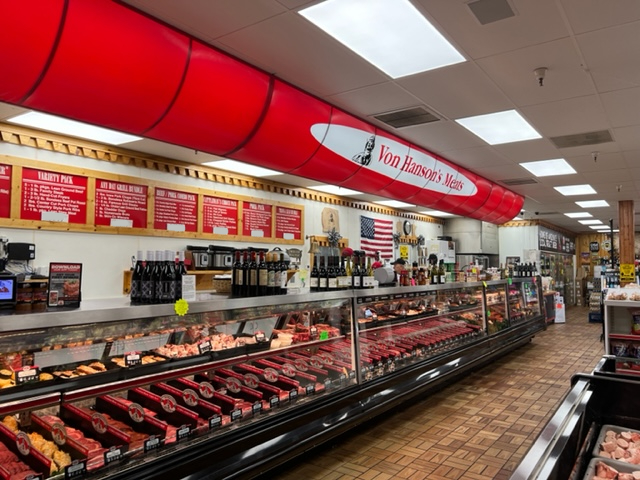Check Out the Neighborhood Flavor at Bagley Farms Meat Market Edwardsville IL: Fresh and Delicious
Check Out the Neighborhood Flavor at Bagley Farms Meat Market Edwardsville IL: Fresh and Delicious
Blog Article
Discover the Art of the Butcher's Cut in a Modern Meat Market
In the ever-evolving landscape of modern-day meat markets, the butcher's cut has actually transcended its traditional origins, combining old-time workmanship with modern techniques. What genuinely sets the contemporary butcher apart is their ability to create a deeper connection between consumers and the beginnings of their meat.
Development of Butchery Strategies

The mid-20th century saw butchery methods further fine-tuned by scientific insights into muscular tissue biology and meat aging, boosting both inflammation and taste. Innovations like vacuum product packaging and refrigeration extended product shelf-life, allowing butchers to diversify offerings and boost quality assurance. This period also noted the surge of customized devices, such as band saws and meat slicers, which enhanced precision and performance in meat processing.
The 21st century has actually introduced electronic modern technology into the butchery realm. Electronic systems currently help in tracking pet provenance and optimizing cuts to satisfy details client preferences. Furthermore, a renewal in artisanal butchery has arised, blending typical abilities with modern understanding to accommodate consumers looking for moral and lasting meat alternatives. This advancement underscores a vibrant interplay between practice and advancement, conference modern demands while preserving the craft's heritage.

Recognizing Meat Cuts

Recognizing the ins and outs of meat cuts is necessary for both butchers and customers seeking top quality and value. Each cut comes from a different component of the animal, presenting unique flavors, appearances, and cooking methods. Mastery of these distinctions not just enhances culinary experiences but likewise takes full advantage of the energy of each carcass. For butchers, accurate cuts mirror skill and respect for the craft, guaranteeing marginal waste and ideal yield.
The key groups of meat cuts consist of primitive, sub-primal, and retail cuts. Butchers after that break these down further right into sub-primal cuts, prior to lastly generating retail cuts offered to customers, like ribeye or tenderloin.
Comprehending muscle mass make-up is crucial; muscles utilized more regularly by the animal often tend to be harder and are best fit for slow cooking approaches, while less-used muscular tissues, like those located in the loin, are more tender and perfect for barbecuing or roasting. Experience with these differences equips customers to make enlightened choices, enhancing their cooking undertakings.
Picking Top Quality Meat
Choosing the ideal meat involves more than simply picking an aesthetically appealing item from the display. The art of selecting quality meat calls for a critical eye and understanding of specific qualities that signify freshness and quality.
Second of all, think about the marbling, which describes the white streaks of fat within the muscular tissue. Proper marbling is a vital indicator of inflammation and flavor, as it melts view it during food preparation, boosting the meat's juiciness. Remember, higher marbling usually correlates with exceptional quality cuts, such as USDA Prime.
Structure is an additional crucial aspect; meat ought to feel strong to the touch, not slimy or excessively soft. Additionally, be mindful of the aroma. Fresh meat must have a clean, neutral scent, devoid of any type of sour or repulsive odors.
Combining Cuts With Food Preparation Methods
Efficiently coupling cuts of meat with the suitable cooking methods is essential for achieving optimal flavor and structure. Different cuts differ in tenderness, marbling, and connective cells web content, each requiring certain techniques to open their potential. For example, tender cuts like filet mignon and ribeye, with their fundamental marbling, take advantage of high-heat, quick-cooking methods such as cooking or pan-searing. These techniques enhance the meat's natural flavors and make certain a juicy finish.
On the other hand, tougher cuts like brisket and chuck roast are rich in collagen, which breaks down into jelly when cooked slowly. These cuts are perfect for braising or slow roasting, permitting the meat to soften with time and develop deep, intricate tastes. Cuts such as brief ribs and pork shoulder make out well with slow-cooking techniques, where prolonged cooking times change their durable appearances right into delicious meals.
Lamb shanks and oxtail, which call for long term food preparation to tenderize, are excellent read review candidates for stewing or slow-moving simmering. These methods coax out rich, passionate flavors while preserving dampness. By comprehending the unique attributes of each cut, chefs and home cooks alike can boost their culinary developments, guaranteeing each dish is both satisfying and memorable.
The Butcher's Function Today
Navigating the developing landscape of the contemporary meat market, the butcher's duty today expands beyond simple preparation of cuts. Contemporary butchers are culinary artisans, teachers, and supporters for sustainable methods.
In addition to crafting accurate cuts, butchers now involve directly with consumers, supplying cooking guidance and customizing selections to fit private demands and preferences. Their expertise in meat aging, marbling, and taste accounts encourages customers to make educated decisions, boosting their culinary experiences. This tailored service exemplifies the butcher's evolving role as a trusted consultant in the kitchen area.
In addition, butchers are critical in decreasing waste, utilizing entire animals to develop diverse products such as sausages and stocks - bagley farms meat market edwardsville il. This extensive strategy not only values the animal yet also aligns with contemporary sustainability objectives. In this way, the modern-day butcher symbolizes both Going Here practice and innovation, adapting to an ever-changing market while maintaining the creativity and honesty of their craft

Conclusion
The contemporary butcher's craft delicately weaves standard strategies with contemporary technologies, emphasizing sustainable techniques and ethical sourcing. Proficiency in recognizing diverse meat cuts and quality indicators empowers butchers to supply informed suggestions, aligning specific cuts with ideal cooking approaches. This proficiency not just elevates cooking experiences but additionally reinforces the connection in between consumers and the beginnings of their food. By honoring historical techniques while welcoming modern demands, the butcher's duty remains vital in today's advanced meat market.
Report this page